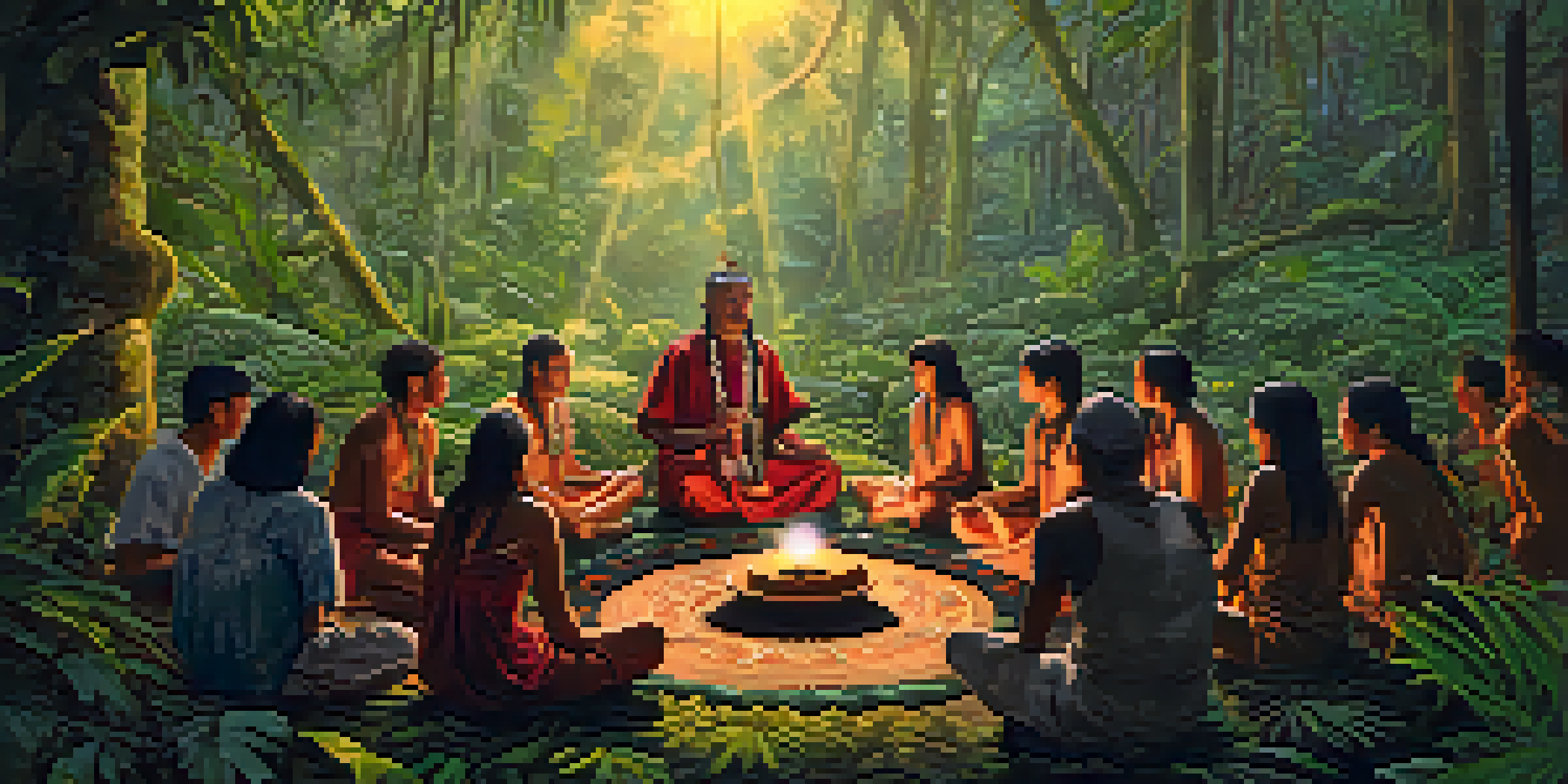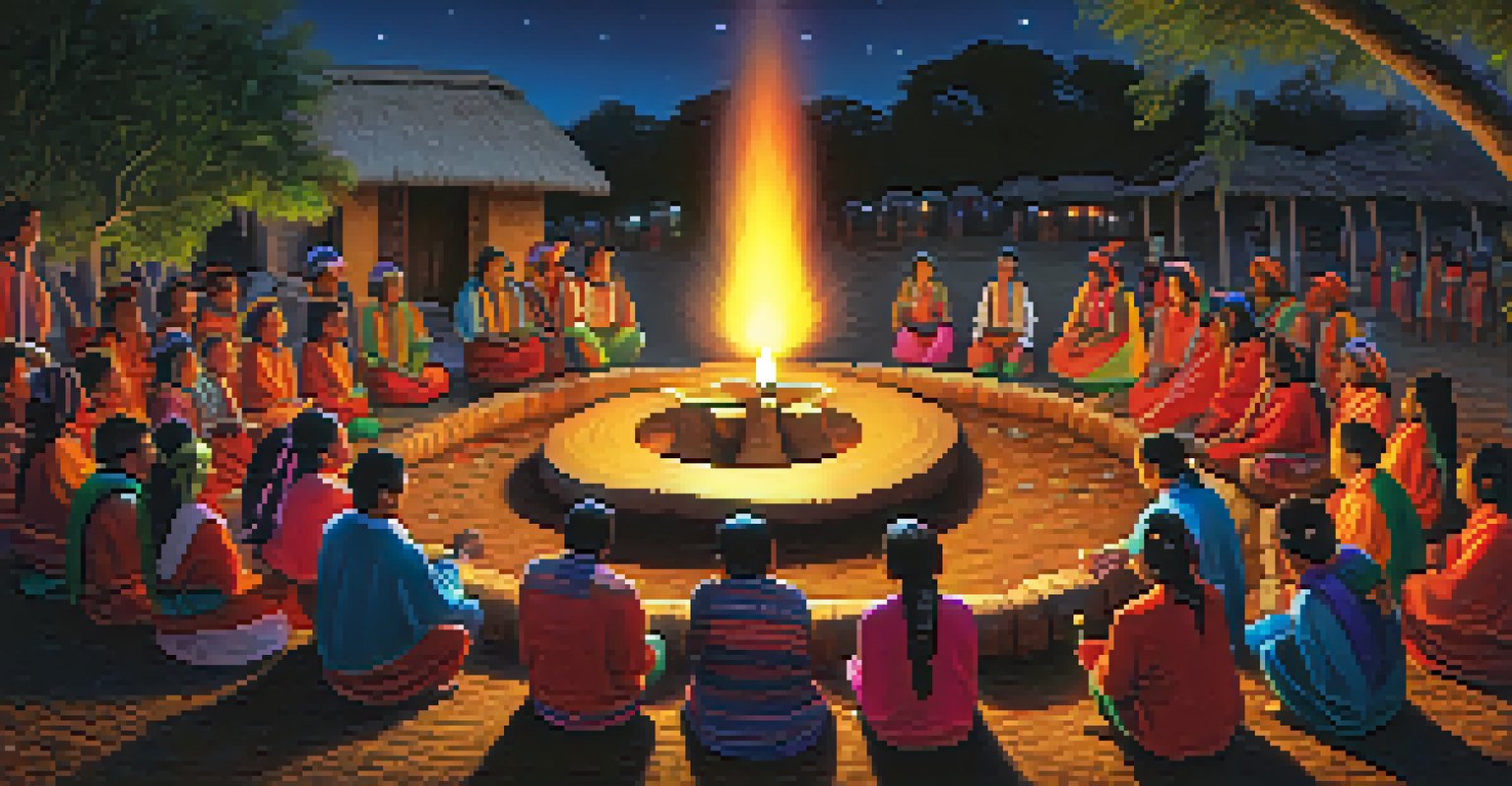The Interplay of Entheogens and Cultural Rituals

Understanding Entheogens: What Are They?
Entheogens are substances that inspire spiritual experiences and alter consciousness, often used in religious contexts. Common examples include psilocybin mushrooms, ayahuasca, and peyote. These substances can help individuals connect with deeper aspects of themselves and the universe, often leading to profound insights.
Psychedelics can help us discover a deeper understanding of ourselves and the universe around us.
In many cultures, entheogens are not just recreational drugs; they serve as bridges to the divine, facilitating communication with higher powers. Their use is often accompanied by rituals that provide structure and meaning to the experience. Understanding their role requires an appreciation of both the substances themselves and the cultural frameworks that surround them.
As we explore the interplay between entheogens and cultural rituals, it's essential to recognize that these experiences are subjective and deeply personal. They can vary widely depending on the individual, the substance used, and the cultural context. This diversity adds richness to our understanding of how these practices shape human experience.
Historical Context of Entheogen Use in Rituals
Throughout history, cultures worldwide have incorporated entheogens into their spiritual practices. Indigenous tribes in the Americas, for instance, have long used peyote in ceremonial contexts, believing it allows them to communicate with ancestors and spirits. This historical usage highlights the deep-rooted connection between these substances and spiritual life.

In ancient Greece, the Eleusinian Mysteries involved the consumption of a secret potion believed to contain psychoactive properties. Participants sought enlightenment and a glimpse of the afterlife, showcasing how entheogens can serve as catalysts for profound transformation. This historical precedent illustrates that the quest for understanding through altered states is far from a modern phenomenon.
Entheogens and Spiritual Connection
Entheogens are used in various cultures as tools to foster spiritual experiences and connect with deeper aspects of the self.
As we trace the lineage of these practices, we see a tapestry woven from shared human experiences and beliefs. The rituals surrounding entheogen use reflect the values and worldviews of the cultures that embrace them, making them a vital aspect of human heritage.
Cultural Variations in Entheogen Rituals
Different cultures have unique approaches to using entheogens in their rituals, often shaped by their specific beliefs and traditions. For example, in the Amazon, ayahuasca ceremonies are conducted by shamans who guide participants through their journeys. This structured format ensures that experiences are meaningful and anchored in cultural wisdom.
The experience of the divine is not merely a product of the substance, but a product of the entire atmosphere and culture surrounding its use.
In contrast, the use of mushrooms in some Mesoamerican cultures, like the Mazatec, often involves a more communal setting where participants engage in prayer and song. This communal aspect underscores the social dimensions of entheogen use, as individuals come together to share in the experience and foster a sense of community.
Understanding these cultural variations reveals how entheogens are not merely tools for personal exploration but are deeply embedded in social and cultural fabrics. Each ritual serves a purpose, whether for healing, divination, or connection to the divine, illustrating the diverse roles these substances play across different societies.
The Psychological Effects of Entheogens in Rituals
The psychological impact of entheogens can be profound, often leading to experiences that alter one's perception of self and reality. Many users report feelings of unity with the universe, enhanced creativity, and emotional healing. These effects can be particularly potent within the context of a ritual, where the environment and communal support amplify the experience.
Research has shown that entheogens can help address mental health issues such as depression and anxiety. In therapeutic settings, guided experiences can lead to breakthroughs and insights that traditional treatments may not achieve. This potential for healing highlights the importance of combining psychological understanding with cultural practices.
Cultural Rituals Shape Experiences
The use of entheogens is deeply embedded in cultural rituals, which provide structure and meaning to users' experiences.
However, it's crucial to approach these substances with respect and caution. The psychological effects can be intense, and without proper guidance, they may lead to confusion or distress. This is where the structured environment of rituals becomes essential, as they provide a safe space for exploration and integration of the experience.
Modern Interest in Entheogens and Spirituality
In recent years, there has been a resurgence of interest in entheogens, particularly among those seeking alternative spiritual experiences. This revival is often characterized by a blend of ancient practices and modern understanding, as people explore how these substances can enhance their spiritual journeys. The contemporary spiritual seeker may find inspiration in the rituals of indigenous cultures while adapting them to fit modern lifestyles.
This growing interest has also led to increased research into the therapeutic potentials of entheogens. As scientists and psychologists study their effects, they are uncovering mechanisms that may explain their profound impacts on consciousness. This intersection of science and spirituality is creating a new dialogue about the role of these substances in human experience.
However, it's essential to approach this newfound interest with cultural sensitivity. As more people engage with these practices, acknowledging and honoring the traditions from which they stem is vital. By doing so, we can foster a respectful exchange that enriches both individual experiences and cultural heritage.
The Role of Ceremony in Entheogen Experiences
Ceremony plays a critical role in shaping the experiences of those who use entheogens. It provides a framework that imbues the experience with meaning, guiding participants through their journeys. Whether it's a formal ceremony led by a shaman or a smaller gathering of friends, the intentionality behind the ritual enhances the psychological and spiritual effects of the entheogen.
Rituals often involve elements such as music, chanting, and guided meditation, all of which help to create a conducive environment for exploration. These practices can ground participants, allowing them to navigate the often-unpredictable terrain of altered consciousness. The shared experience can also foster a sense of connection, both to others and to something greater than oneself.
Ethics in Entheogen Practices
As interest in entheogens grows, ethical considerations regarding cultural respect and participant safety become increasingly important.
Ultimately, the ceremony transforms the use of entheogens from a mere consumption of substances into a deeply enriching experience. It allows individuals to reflect on their journeys and integrate insights into their daily lives, making the ritual an essential component of the entheogenic experience.
Ethical Considerations in Entheogen Use
As interest in entheogens grows, so do the ethical considerations surrounding their use. It's vital to respect the cultures that have traditionally used these substances, ensuring that practices are not appropriated or commercialized. Engaging with these rituals requires sensitivity and acknowledgment of their historical significance.
Furthermore, the safety and well-being of participants should always be a priority. Proper education about the substances, their effects, and the potential risks is crucial for anyone considering their use. This responsibility extends to facilitators of ceremonies who must ensure a safe and supportive environment for all participants.

By fostering an ethical approach to entheogen use, we can honor the rich traditions from which they originate and create spaces for meaningful exploration. This respect not only benefits individuals but also contributes to the preservation of cultural heritage and wisdom.